
Combining aerobic and anaerobic exercise provides a solid foundation for a heart-smart fitness routine.
You may have heard that your body is a temple. Well, it’s not. Your body is a car and your heart is the engine. Some drive sports cars, some drive trucks, and others are riding the bus. If the engine isn’t running smoothly, we aren’t going anywhere fast.
Like any good car owner, we pay mechanics big bucks for expensive tune-ups and oil changes to keep our engines in peak running condition. Our bodies, like our cars, need that same due care and attention. Luckily for us, we can arm ourselves with the knowledge and tools to do the job ourselves, saving on the expensive parts and labour.
The art of being heart-smart may sound challenging, but physiologically speaking, there are two basic ways to exercise the body—aerobic and anaerobic training. Understanding the difference between the two and learning how to incorporate both types of training into a program will give you a solid foundation for your heart-smart routine.
Aerobic
Aerobic training refers to the body’s ability to take in oxygen and pump it to working muscles in order to fuel motion over long periods of time, such as with running. Muscles use oxygen in combination with carbohydrates, fats, and, to a lesser extent, proteins as their gasoline.
The heart, in this case, is the engine that works to ensure that the muscles are being pumped as much oxygen as they require to maintain locomotion. When muscles work harder than their normal resting levels, more oxygen is needed and the sympathetic nervous system signals the heart and lungs to work harder and faster.
If we are unconditioned, our hearts will yell, “Mercy!” before we can complete the task. This is the part where we trade in our old car for a new one. With proper aerobic training, the heart becomes more efficient at pumping blood and stronger with each push. We can now continue our activity for longer or at a higher intensity without feeling like lunch is coming back up to say hello.
Engaging in regular aerobic training significantly reduces our risk of developing cardiovascular disease and stroke, according to the Heart and Stroke Foundation. Risk factors for cardiovascular disease (including obesity, high blood pressure, and high cholesterol), as well as type 2 diabetes, osteoporosis, and even certain types of cancers can also be prevented or managed with regular aerobic exercise.
Anaerobic
Anaerobic training is the body’s ability to work in the absence of oxygen for short periods of time, such as with weight training. Following a quick burst of activity, our muscles ache from lactic acid. As our hearts become strong from aerobic training, they also become more effective at recovering and getting much needed oxygen to the muscles.
Traditionally, strength training has been avoided as a means of cardiac rehabilitation due to presumed excessive stress on the heart. However, new research is showing that not only is strength training less stressful on the heart than aerobic training (determined by the peak systolic blood pressure multiplied by the peak heart rate), but it also has been shown to have beneficial effects on resting blood pressure, HDL levels (“good cholesterol”), and self-efficacy.
This heart-smart workout is the perfect combination of aerobic and anaerobic exercises. Each exercise is a “station” with anaerobic exercises performed for 15 to 20 repetitions and aerobic exercises performed at 90-second intervals. Complete two to three rounds of the circuit, allowing for 30 seconds of rest between stations.
Here are the keys, take it for a spin …
 Station 1: aerobic – cross-country skier (90 seconds)
Station 1: aerobic – cross-country skier (90 seconds)
Start in a standing position. In a hopping motion, drop one leg back and stretch it behind you so that you are in a lunge position. At the same time, raise the opposite arm straight up in front of you. As you lower your arm, hop to change your leg positions so that the other leg is back and the first leg is forward, allowing your other arm to rise. Repeat this alternating motion.
Variation: for low impact, remove the hop and simply touch your foot back with alternating arms in front.
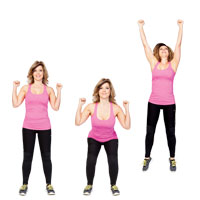 Station 2: anaerobic – squat and press (15 to 20 reps)
Station 2: anaerobic – squat and press (15 to 20 reps)
Stand with your feet shoulder-width apart and your toes pointed forward. Begin with your hands resting just above your shoulders with elbows pointing forward. Squat down as far as you can as if you were sitting into a chair. When you get to the bottom of the squat, stand straight up with force by pushing your hips forward. At the same time, extend your arms straight up toward the ceiling.
Variation: to add difficulty, hold dumbbells in each hand. No dumbbells handy? You can even grab a couple of cans of soup!
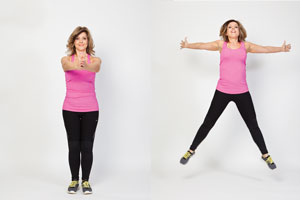 Station 3: aerobic – star jacks (90 seconds)
Station 3: aerobic – star jacks (90 seconds)
For this jumping jack-like exercise, begin in a standing position with your arms outstretched in front of you at shoulder height with palms together. With knees slightly bent, jump your legs apart beyond shoulder width while opening your arms out to the sides. Return to the starting position by hopping your feet in together and closing arms.
Variation: for low impact, simply step to the side and return feet together, alternating the starting foot.
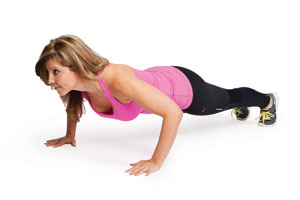 Station 4: anaerobic – push-ups (15 to 20 reps)
Station 4: anaerobic – push-ups (15 to 20 reps)
Start in a plank position on the ground with your hands just wider than shoulder width. Your feet should be together and your hips should be the same height as your shoulders. Slowly lower yourself toward the ground until your elbows make a 90-degree angle and then push yourself back up to the starting position.
Variation: for low intensity (if a push-up proves too difficult to do from your toes), you can complete the exercise from your knees.
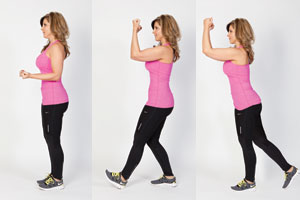 Station 5: aerobic – Heel and toe taps (90 seconds)
Station 5: aerobic – Heel and toe taps (90 seconds)
Begin standing with your feet together, Knees slightly bent, and arms bent at a 90-degree angle at your sides. Stretch Your left leg and tap your left heel to the Ground in front of you while allowing Both arms to swing forward until your Elbows reach shoulder height. Return To the starting position. Then, let the Right leg extend backward and tap your Right toe behind you. Again allow your Arms to swing forward until they reach Shoulder height. Return to the starting Position. Be sure to switch the starting Foot at the 45-second mark.
Variation: for low intensity, relax arms At your sides, performing only the heel Tap to the front, and alternate legs.
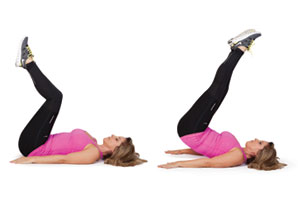 Station 6: anaerobic – Reverse crunch (15 to 20 reps)
Station 6: anaerobic – Reverse crunch (15 to 20 reps)
Begin lying on your back with your Legs in the air at a 90-degree angle. Legs may be slightly bent. Arms May remain on the ground on either Side of the body. Lift your hips off The ground while trying to extend Legs toward the sky. Only a few Inches are needed to engage the Core muscles. Return to the starting Position and repeat.
Variation: to increase difficulty, Cross your arms over your chest.
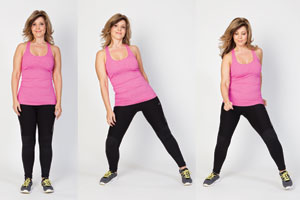 Station 7: aerobic – salsa side step (90 seconds)
Station 7: aerobic – salsa side step (90 seconds)
Begin standing with your feet together and knees slightly bent. Starting with the right foot, step to your right, allowing your weight to shift onto the right foot. Now, pick up the left foot and step in place. Return to the starting position and repeat two more times. Repeat the same combination with the left foot. Arms are free-moving and can do whatever feels natural to you.
Variation: to increase difficulty, increase your speed and add some hip circles to engage your core.
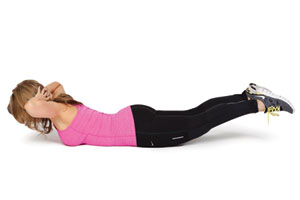 Station 8: anaerobic – Supermans (15 to 20 reps)
Station 8: anaerobic – Supermans (15 to 20 reps)
Lie face down on the ground with your legs hip-width apart and your arms placed behind your head. On the inhale, extend your back so that your chest and legs lift off the ground. Be sure to relax your neck muscles and focus on using your mid-low back (opening the chest) and glutes (extending the legs). Keep your head in line with your spine by keeping your eyes on the floor. Only a few inches are needed to feel the effects. Timing is 2 seconds rise, 2 seconds hold, and 2 seconds lower.
Variation: to increase difficulty, extend your arms overhead so that they are straight.
Your fitness plan length, intensity, and frequency may vary based on your individual needs, but remember that the key to gaining important health benefits is including a combination of both aerobic and anaerobic exercises. Before you start any fitness program, consult your health care practitioner.
And don’t forget, it doesn’t matter how many tune-ups we get if we are putting diesel into a gasoline engine. Consult your local natural nutrition and supplement store to find the fuel that will have your ticker purring!



































